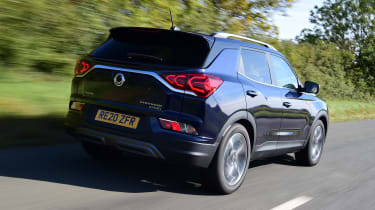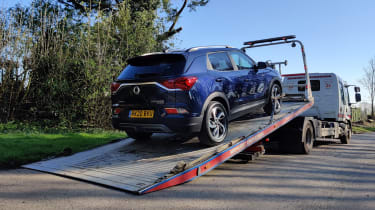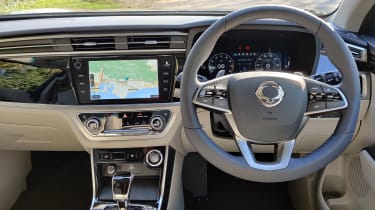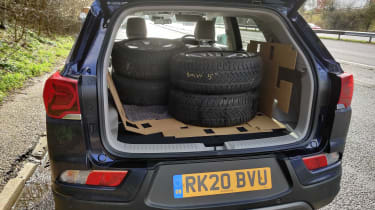SsangYong Korando Ultimate: long-term test review
Final report: our time with SsangYong Korando SUV has left us with very mixed feelings
Verdict
The SsangYong Korando is a serious player in the mid-size SUV sector and shouldn’t be overlooked. I can’t deny that it’s given me both good and bad memories, but although the early battery problems have slightly tarnished my view of the car, overall I’m sad to see it leave.
- Mileage: 4,002
- Economy: 29.8mpg
Hyundai and Kia have not always been the automotive powerhouses that they are now in the UK. They had to work hard to build up their reputation for superb reliability and build quality. So can fellow South Korean maker SsangYong follow suit?
SsangYong models are a rarity – chances are you won’t see one on the road when you next leave the house – but the brand’s cars are getting better. Gone are the out-of-date interiors and strange styling of some of its earlier models. Arguably the best car the firm makes is the new Korando, and I ran one on the fleet for the best part of the last year to see if the brand could finally challenge some of the players in the crowded mid-size SUV sector.
Has it achieved it? Well, yes and no. During my time with the Korando, I’ve been left both seriously impressed and wishing that I had another car on my driveway.
Used - available now

2023 Audi
Q4 Sportback e-tron
54,526 milesAutomaticElectric
Cash £23,363
2022 Kia
Niro
18,315 milesAutomaticPetrol1.6L
Cash £17,900
2023 Nissan
Juke
40,858 milesManualPetrol1.0L
Cash £12,287
2022 Volkswagen
T-Roc
36,779 milesAutomaticPetrol1.5L
Cash £18,600Let’s start with the negatives. Firstly, my original car had to be replaced because it developed a problem after the battery went flat. It simply wouldn’t hold charge and was dead nearly every time I went to start it. The problem was never resolved, so a new car was delivered. I never had any issues from then on, but it took time to restore my trust.
Then there’s the engine. The 1.5-litre turbocharged petrol unit produces a solid 161bhp, but it feels like it’s from an era that’s now been left behind. Although it’s actually quite a refined unit around town, it can get a little noisy under acceleration, and it sometimes feels a little short of pace, too.
By far the biggest issue is fuel economy, though. I’ve had to really battle to get above 30mpg. Considering this model is only two-wheel drive, it’s disappointing to see such a poor return from my (all too regular) trips to the pumps. It’s certainly a black mark for the Korando next to its talented rivals, especially as we have previously tested a Skoda Karoq 1.5 TSI on our fleet and it returned a far more respectable 37.5mpg.
However, the positive news is that the Korando is evidence of a giant leap forward for the manufacturer in many other ways. The sheer amount of space on offer makes it perfect for families with two children like mine. I did wonder if the Korando simply felt so big because I moved straight into it from a BMW 1 Series, but my neighbour has a Renault Kadjar and the Korando dwarfs it. Considering they are rivals, it’s a surprise that the Korando looks and feels so big.
It’s swallowed everything that’s been thrown at it, from all the bags, buggies and carrycots needed for a few days away in the countryside last summer, to the numerous shopping bags from our regular trips to the supermarket. Plus, the ample rear legroom means the children are not constantly kicking the seats in front of them.
The interior quality has also come as a nice surprise – it feels far more premium than I expected. It’s not at BMW levels by any means, but that’s not a brand SsangYong is targeting.
While this top-spec Ultimate model may sound quite pricey, it’s full of kit – mostly things that would quickly add up if you optioned them on other brands’ cars. Heated and cooled seats, a digital cockpit, keyless entry and a powered tailgate are all standard. My wife was a big fan of the crystal-clear reversing camera, and I agree. The display showed more of what’s behind than I’ve seen in other cars, and the camera was mounted where it never needed cleaning.
SsangYong Korando: third report
Second time lucky for the spacious and practical SsangYong Korando SUV
- Mileage: 2,111
- Economy: 31.5mpg
Spot the difference! The SsangYong Korando you see before you looks just like the car that arrived on our fleet in April, but look closer and you’ll notice it’s not.
It’s the same colour, the interior is identical and it’s also a top-spec Ultimate model. In fact it’s so similar that the only real giveaway is the registration plate.
But why am I testing a different car? The first Korando got stuck at a SsangYong dealer during lockdown and the battery was flat when I went to pick it up. After that, it was besieged by battery gremlins, going flat within days of being recharged multiple times. It was returned to SsangYong and I was given the keys to a facelifted Tivoli while I waited for it to be fixed. The cause of the problem had everyone flummoxed and it was eventually decided to replace the car.
I’m not going to lie: after all the issues, I was initially a little apprehensive each time I tried to start the replacement car. However, it has been faultless since its arrival and I have slowly become more confident that it’s not going to let me down.
Now that I have been able to spend some time with it, the Korando’s main selling points are really starting to shine.
Firstly, there’s the practicality. It’s a big car that dwarfs most of its rivals in the crossover class inside and out, meaning there’s more than enough room for me, my wife and our children whenever we go on a family trip. A recent holiday to Gloucestershire really put its load- carrying ability to the test, but the Korando swallowed all of our luggage, as well as a pushchair and travel cot, and even had a little space to spare.
The 1.5-litre turbocharged petrol engine is a delight because it’s quiet and smooth driving around town. Only under hard acceleration is the noise noticeable, but even then it’s far from unpleasant.
Performance has also been a nice surprise. I’d expected the engine to struggle because it takes 12 seconds to propel the Korando from 0-62mph, but in day-to-day use it feels much keener. It’s not exactly quick, but it never really feels underpowered either.
Fuel economy is a bit of a concern, though, since I’ve only been averaging around 31mpg so far and the relatively small 50-litre fuel tank means I have to make regular trips to the pump to fill up. If you’re planning on covering plenty of miles, the 1.5-litre diesel might be a better choice given that SsangYong claims economy figures of around 41mpg, but we found it noisy and lethargic when we tested it.
Top-spec Ultimate models like ours come packed with kit, some parts of which are more beneficial than others. I’ve made good use of the cruise control, rear-view camera and powered tailgate, while the 10.25-inch digital Blaze Cockpit looks fantastic and is easy to configure.
One feature that I hadn’t had much experience of in the past is the ventilated seats, but they were used a lot during the hot summer days. They are really effective and cool you down quickly as soon as they are switched on, but the heating facility is likely to get more use as we head into autumn.
The cream leather interior looks great but, as expected, it’s a nightmare with two young children. My eldest loves to kick the back of the passenger seat and it’s already covered in shoe marks that are proving hard to shift. Plus, the dye from my blue jeans seems to have left a mark on the driver’s seat, which is a little disappointing. It often feels like I spend almost as much time trying to clean the interior as driving the car.
SsangYong Korando Ultimate: second report
The new SsangYong Korando is a world away from the car it replaced. It’s relatively refined and the quality of the interior is a pleasant surprise, but I just wish it were a bit more enjoyable from behind the wheel
- Mileage: 1,100
- Economy: 37.2mpg
I’ve finally got the keys to the new SsangYong Korando Ultimate I’m running on the Auto Express fleet. I’ve been waiting for a while, because it spent most of lockdown stuck in a garage after getting a puncture, but it’s finally been released and I can’t wait to spend some time with it.
I’m mainly looking forward to this for one reason: space. I’ve been running a BMW 1 Series for the past six months and it’s been great fun to drive, but there’s recently been a new addition to my family (since the above picture was taken), and I definitely need the extra space and practicality of a compact SUV.
The 1 Series did surprise me with how much room it had, but it simply can’t match the Korando when it comes to boot space and legroom. It was so much easier for my heavily pregnant wife to get in and out of the SsangYong, and after our second child arrived, with two car seats to account for, the roomy interior really helped.
The first time my wife got in the Korando and sat down on the comfy seats there was a huge smile on her face. The extra space meant she could also recline the seat and get as comfortable as possible. That’s something she was only able to do in the 1 Series by eating into the rear passenger legroom.
The boot also offers an impressive 551 litres of space (1,248 litres with the rear seats folded down), easily trumping rivals such as the Nissan Qashqai (430 litres), Renault Kadjar (472 litres) and SEAT Ateca (510 litres). As you would expect, it’s also significantly more than the 380 litres on offer in the 1 Series, meaning I can squeeze in all the extra stuff needed for a new baby.
The Korando range starts at less than £20,000, but our top-spec Ultimate model costs more than £28,000. And although that might seem expensive, the car does come with plenty of kit; in fact, it’s a bit of a struggle to find anything that’s missing. Luxuries such as heated and cooled electric leather seats, a heated steering wheel, a rear-view camera, keyless operation, Apple CarPlay and Android Auto connectivity, LED headlights, 19-inch alloy wheels and much, much more are all included.
Arguably, the best feature of all is the impressive Blaze Cockpit. Standard on Ultimate models, it combines a 10.25-inch digital instrument cluster and a nine-inch HD central infotainment screen. It looks as good as almost any system on the market in this segment and it’s really easy to flick through the different menus and views using the controls on the steering wheel. The system also allows you to change the LED interior lighting across the fascia and front doors, with a choice of 34 colours.
True, there are a few cheap-looking materials throughout the cabin, but overall it’s a thoroughly pleasant place to be.
I’ve sent a few pictures to my friends and family, and they have been very surprised at just how luxurious it looks. I guess that’s why the company’s marketing slogan is ‘Surprisingly SsangYong’.
One area where the Korando isn’t quite as good is in the way it drives. Although I haven’t been able to give it a thorough test yet (more on why soon), it’s become immediately apparent that it’s not as competent as some sharper SUV rivals.
There’s plenty of body roll, meaning the car doesn’t feel as planted as I’d like. Sure, you’re not exactly going to expect hot hatch thrills in a compact SUV, but many of this car’s rivals simply do a better job.
The 1.5 GDI-Turbo petrol engine (there’s also a 1.6 diesel engine available) boasts a decent 161bhp, but it’s short of torque, at just 280Nm. It’s not fast, either, taking 12 seconds to ‘sprint’ from 0-62mph. The lack of power isn’t really that noticeable around town, but come to a motorway slip road and you do wish there were a bit more.
While the Korando does disappoint when it comes to power and dynamics, it means the overall driving experience is relaxed. I’ve found myself taking my time and not rushing to get to places.
At least the engine is relatively refined, with the smooth six-speed automatic ’box adding to the car’s calm nature. Let’s not forget the fantastic seven-year/150,000-mile warranty that SsangYong throws in as standard, either. If anything were to go wrong, it’s good to have that peace of mind.
SsangYong Korando Ultimate: first report
Puncture aside, the SsangYong Korando SUV has made a solid start on our fleet (by Ben Hodges)
This is the newest member of the Auto Express test fleet: a SsangYong Korando. We took delivery of the car just before the country went into lockdown – and my time in it has gone from what was supposed to be a couple of days into months.
With a range starting from a shade under £20,000, it initially seems to be a reasonably priced SUV that undercuts rivals like the Peugeot 3008 and Ford Kuga. However, step up through the trim levels to the flagship Ultimate model – as we have here – and the starting price of £28,345 puts the Korando much closer to its rivals – so it’ll have to beat them on their own terms.
The car we’ve added to our test fleet is a 1.5-litre petrol model, with an automatic gearbox and front-wheel drive only.
While the exterior design of the Korando is likely to split opinion, and I’ll admit to not being entirely sold on the looks just yet, its optional ‘Dandy Blue’ metallic paint finish (£550) and the standard-fit 19-inch alloy wheels are smart enough. The angular design is something you don’t see on every family SUV, so it’s distinctive.
The Korando Ultimate gets plenty of other standard equipment, too, including LED daytime running lights, foglamps and tail-lights. Inside, leather seats that can be heated and cooled are a welcome upgrade, along with climate control and auto wipers.
The fully digital instrument cluster is another impressive feature, with a 10.25-inch panel that joins the nine-inch touchscreen infotainment system.
My first impressions of the onboard tech are that it’s good, because the digital dials are easy to read and operate, and connecting my phone to Android Auto was a simple task – aside from having to tap the on-screen ‘consent’ button every time I start the car.
Despite the Korando Ultimate getting pretty much every conceivable item I could ever want, the quality is slightly let down in places; there are cheap, flimsy-looking plastics which stand out from the higher- quality materials in certain places in the cabin. Also, with a light colour scheme, keeping the interior clean might be a tough task in the coming months, so I will be interested to see how it holds up.
The 1.5-litre turbocharged petrol engine produces 161bhp and 280Nm of torque. While those are not powerhouse numbers, on my few motorway trips before lockdown, the engine delivered relaxed progress, with the six-speed automatic gearbox being smooth enough, if a little slow to react if I want it to select a lower gear when pressing the throttle. At faster speeds and while accelerating hard, the engine is a bit coarse, so it’s best to keep things relaxed.
This calm nature continues with the handling, which is typical of a car of this type. There’s a decent amount of grip, but lifeless steering and a small amount of body roll mean it’s not much fun to drive.
Having only spent a couple of weeks with the Korando before the UK went into lockdown, it has met every challenge I’ve asked of it so far. Being an owner of two older cars that always need replacement parts, the Korando’s sizable 551-litre boot has proven useful, with space for a full set of replacement wheels for my BMW 5 Series.
Our short time with the SsangYong hasn’t been entirely uneventful: we picked up a puncture while on a local trip.
This raises my only gripe with the Korando: the lack of a spare wheel, which is not an available option on this Ultimate- specification car.
This meant the split tyre led to a trip on a tow truck, thanks to SsangYong’s excellent roadside assistance package – the truck quickly swung into action to recover the car.
The Korando’s rubber was replaced straight away by my local dealership, but that was just before the UK shut down. This means the car is still in their car park and we’ve not driven it since. We can’t wait to go and pick it up once this is all over.
| Model: | SsangYong Korando 1.5 GDi-T Auto Ultimate |
| On fleet since: | April 2020 |
| Price new: | £28,745 |
| Engine: | 1.5-litre 4cyl turbo, 161bhp |
| CO2/tax: | 180g/km/£150 |
| Options: | Metallic paint (£650) |
| Insurance*: | Group: 24 Quote: £455 |
| Mileage/mpg: | 4,002/29.8mpg |
| Any problems? | Battery issue prompted replacement car |
*Insurance quote from AA (0800 107 0680) for a 42-year-old in Banbury, Oxon, with three points



















